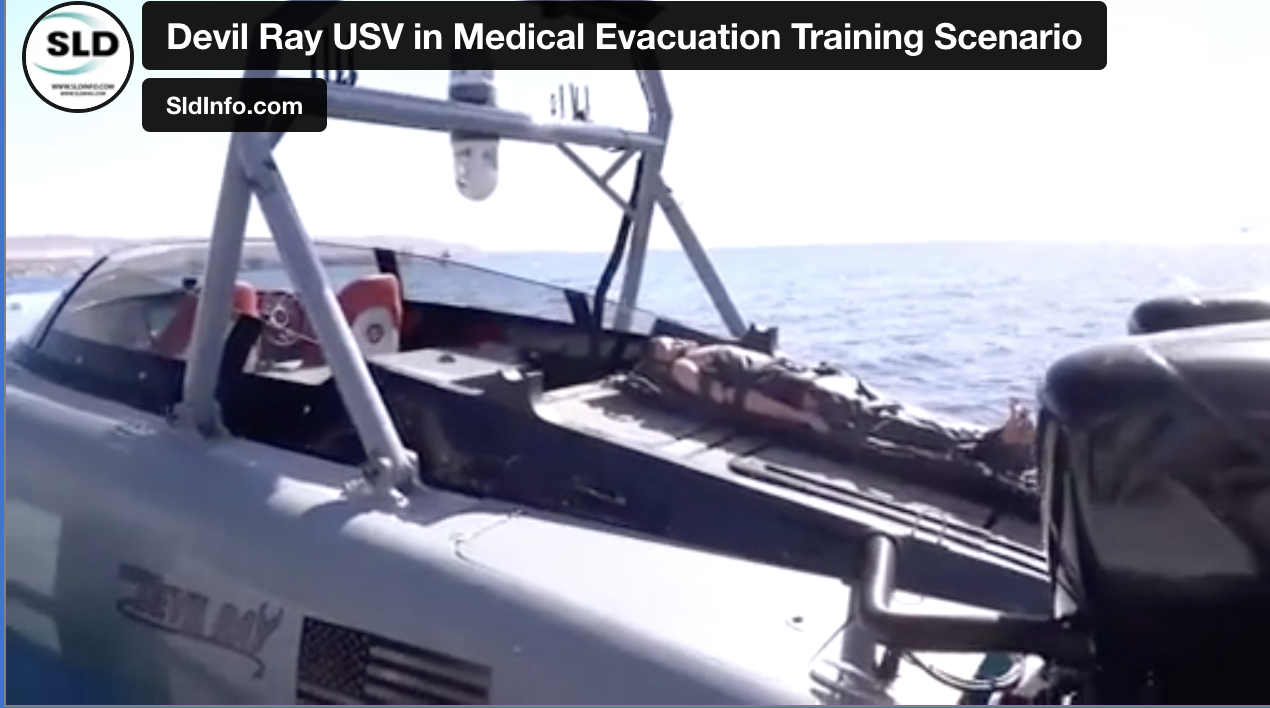Payloads and USVs: Transporting the Wounded
Ed Timperlake and I focused on the shift from platforms to payloads in shaping multi-domain combat forces.
This means that one needs to consider the payloads which can operate in the operational area designed to achieve the desired effect.
With regard to USVs, the performance of the platform is crucial but one evaluates its contribution in terms of what payloads it can deliver.
In an interview last year with Bruce Hanson CEO of MARTAC, the builder and operator of a number of USV systems, we discussed how his platforms can deliver a wide variety of payloads.
“The range of scalable catamarans by MARTAC are designed to be operated with robust systems software onboard and a variety of communications capabilities to deliver mission commands to the autonomously operating boats. That software has been designed from the outset to work with a wide variety of payloads. The company involved made the decision from the outset not to design for specific payloads but to provide interfaces that could work with adaptation to the operating system across a wide range of payloads.
“This has two key advantages. First, there is a very dynamic process underway in industry and the U.S. and allied militaries to develop payloads for maritime systems. Configuring your boat for a narrowly defined payload would lead to obsolescence. Second, allies and partners can operate these vessels with their own payloads onboard, which means that there is a much wider opportunity to develop national solutions that can enable payload sharing, notably in the ISR domain. The MARTAC boats—notably the Mantas 12-foot boat and the Devil Ray 38-foot boat—have demonstrated in many U.S. and allied naval exercises a wide variety of payloads that can operate from their boats and deliver specific mission capabilities.”
We then discussed a number of payloads including medical evacuation.
This is what was emphasized in the interview.
“In another exercise, the extraction of special forces from a beach was managed by the Mantas and the Devil Ray. In the exercise, there were two “injured” special forces soldiers who needed medical attention. The Devil Ray launched the Mantas with a sled attached to reach the shore. The “injured” special forces soldiers were put onto the Mantas and the sled and joined by one uninjured special forces soldier on both the Mantas and the sled. The Mantas and the sled went back to the Devil Ray, where the injured soldiers received triage from medics onboard the Devil Ray. After initial triage, a helicopter lifted the soldiers off of the Devil Ray, and the Devil Ray with the Mantas “nested” returned to the desired landing area. Working Search and Rescue:
“Aiding a Distressed Diver In this exercise, four divers were involved, with one playing the role of the distressed diver. The T-38 Devil Ray launched the Mantas T-12. The T-12 then went to the distressed diver who grabbed onto the T-12 and the T-12 then went back to the Devil Ray. When the diver reached the Devil Ray, the diver was manually placed in a basket for movement by helicopter to the shore. The diver was replaced by a dummy for the last piece of this recovery and the transfer to the helicopter.
“But this exercise suggests a broader range of options. The exercise clearly demonstrated the possibility of a search and rescue scenario in which the autonomous asset could operate in weather too dangerous for manned operations. And suggested as well that the Devil Ray is able, because it “can operate beyond human capability,” to get to the location of a sinking ship much faster than a manned asset. These are some key operational capabilities this maritime autonomous system has that allow these kinds of missions to be executed quite differently from a manned platform or a remotely piloted UAS system.”
That interview can be read in my just published book, Defense XXII: A World in Transition.
But since the interview, the U.S. Navy has recently demonstrated how the medical evacuation mission and the patient as a payload could work.
In the video below,. U.S. Navy Sailors simulate a ship-to-shore patient transfer using a MARTAC T-38 Devil Ray unmanned surface vessel (USV) in Aqaba, Jordan, March 9, 2023, during International Maritime Exercise 2023.
The USV transferred a mannequin from the Gulf of Aqaba to land, marking the first time the unmanned platform has been used to execute a medical evacuation training scenario.
AQABA, JORDAN
03.12.2023
Video by Spc. Aaron Troutman
U.S. Naval Forces Central Command / U.S. 5th Fleet
Devil Ray USV in Medical Evacuation Training Scenario from SldInfo.com on Vimeo.

